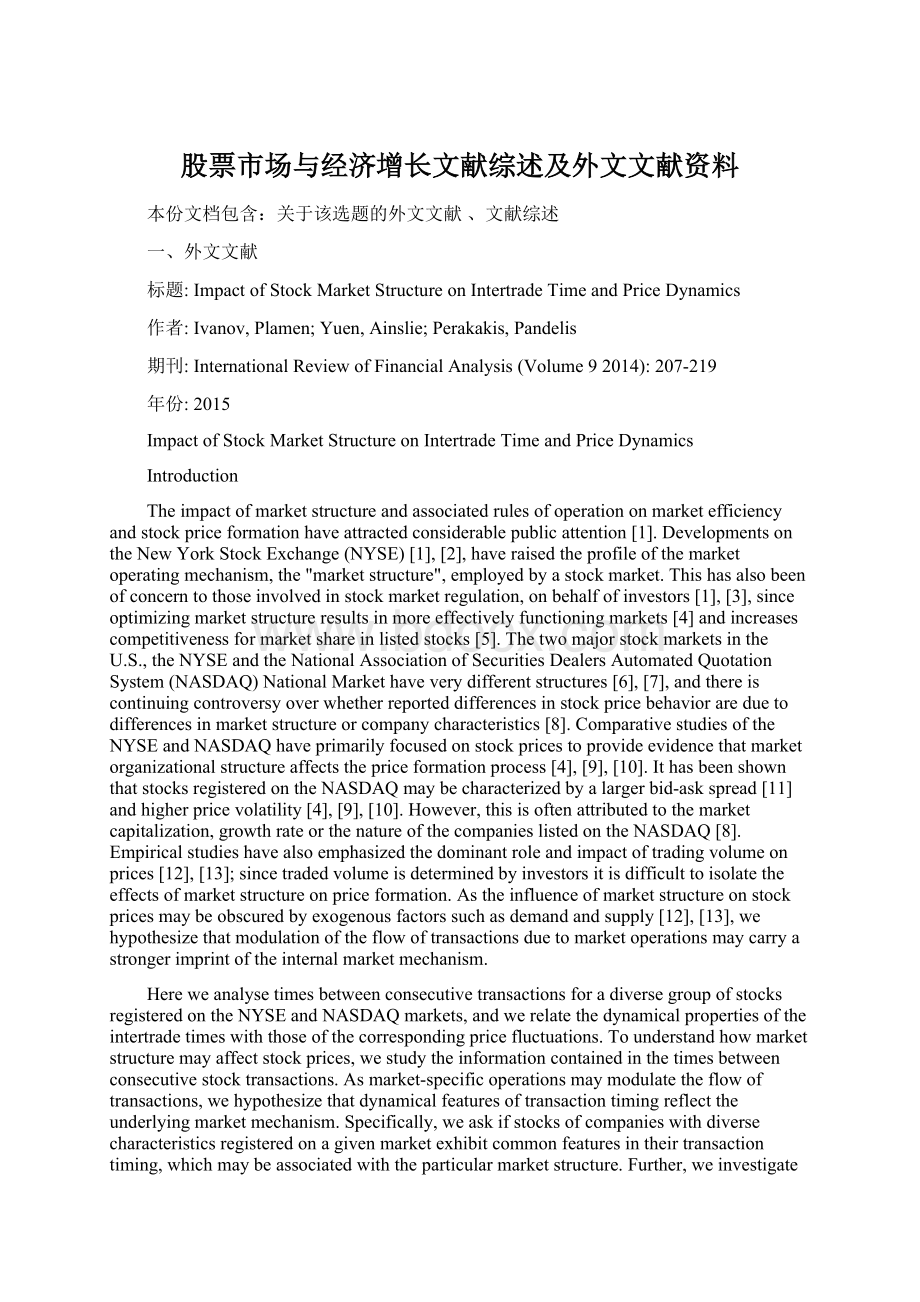股票市场与经济增长文献综述及外文文献资料文档格式.docx
《股票市场与经济增长文献综述及外文文献资料文档格式.docx》由会员分享,可在线阅读,更多相关《股票市场与经济增长文献综述及外文文献资料文档格式.docx(14页珍藏版)》请在冰豆网上搜索。

ImpactofStockMarketStructureonIntertradeTimeandPriceDynamics
作者:
Ivanov,Plamen;
Yuen,Ainslie;
Perakakis,Pandelis
期刊:
InternationalReviewofFinancialAnalysis(Volume92014):
207-219
年份:
2015
ImpactofStockMarketStructureonIntertradeTimeandPriceDynamics
Introduction
Theimpactofmarketstructureandassociatedrulesofoperationonmarketefficiencyandstockpriceformationhaveattractedconsiderablepublicattention[1].DevelopmentsontheNewYorkStockExchange(NYSE)[1],[2],haveraisedtheprofileofthemarketoperatingmechanism,the"
marketstructure"
employedbyastockmarket.Thishasalsobeenofconcerntothoseinvolvedinstockmarketregulation,onbehalfofinvestors[1],[3],sinceoptimizingmarketstructureresultsinmoreeffectivelyfunctioningmarkets[4]andincreasescompetitivenessformarketshareinlistedstocks[5].ThetwomajorstockmarketsintheU.S.,theNYSEandtheNationalAssociationofSecuritiesDealersAutomatedQuotationSystem(NASDAQ)NationalMarkethaveverydifferentstructures[6],[7],andthereiscontinuingcontroversyoverwhetherreporteddifferencesinstockpricebehaviorareduetodifferencesinmarketstructureorcompanycharacteristics[8].ComparativestudiesoftheNYSEandNASDAQhaveprimarilyfocusedonstockpricestoprovideevidencethatmarketorganizationalstructureaffectsthepriceformationprocess[4],[9],[10].IthasbeenshownthatstocksregisteredontheNASDAQmaybecharacterizedbyalargerbid-askspread[11]andhigherpricevolatility[4],[9],[10].However,thisisoftenattributedtothemarketcapitalization,growthrateorthenatureofthecompanieslistedontheNASDAQ[8].Empiricalstudieshavealsoemphasizedthedominantroleandimpactoftradingvolumeonprices[12],[13];
sincetradedvolumeisdeterminedbyinvestorsitisdifficulttoisolatetheeffectsofmarketstructureonpriceformation.Astheinfluenceofmarketstructureonstockpricesmaybeobscuredbyexogenousfactorssuchasdemandandsupply[12],[13],wehypothesizethatmodulationoftheflowoftransactionsduetomarketoperationsmaycarryastrongerimprintoftheinternalmarketmechanism.
HereweanalysetimesbetweenconsecutivetransactionsforadiversegroupofstocksregisteredontheNYSEandNASDAQmarkets,andwerelatethedynamicalpropertiesoftheintertradetimeswiththoseofthecorrespondingpricefluctuations.Tounderstandhowmarketstructuremayaffectstockprices,westudytheinformationcontainedinthetimesbetweenconsecutivestocktransactions.Asmarket-specificoperationsmaymodulatetheflowoftransactions,wehypothesizethatdynamicalfeaturesoftransactiontimingreflecttheunderlyingmarketmechanism.Specifically,weaskifstocksofcompanieswithdiversecharacteristicsregisteredonagivenmarketexhibitcommonfeaturesintheirtransactiontiming,whichmaybeassociatedwiththeparticularmarketstructure.Further,weinvestigatehowthedynamicalpropertiesoftransactiontimingoverarangeoftimescalesrelatetostockpricedynamicsandwhethermarketstructureaffectsthetemporalorganisationofpricefluctuations.
Toprobehowmarketstructureinfluencesthetradingofstocks,weconsiderthetwomajorU.S.stockmarkets,theNYSEandtheNASDAQ.AlltransactionsontheNYSEofagivenstockarecentralisedandarecontrolledbyasinglehumanoperatorcalleda"
specialist"
whoseprimaryroleistomatchtogetherpublicbuyandsellordersonthebasisofprice,inanauction-likesetting[6].TheNYSEspecialistisunderobligationtomaintainbothpricecontinuityanda"
fairandorderlymarket"
[6],aswellastointervene,usinghisownfirm'
sinventoryofavailablestock,toprovideliquidityintheeventofanorderimbalance,thuspreventingsharpchangesinthestockprice[6].TheNYSEregulationsallowforconsiderableflexibilitywithinthespecialist'
soperations[2].
Incontrast,tradingontheNASDAQisdecentralised,withtradinginagivenstockmanagedbyanumberofdealerscalled"
marketmakers"
.Thesemarketmakersmaintainastockinventory,postingtheirbestpricesatwhichtheyarepreparedtoimmediatelybuyandsellstock[7].Marketmakerscompetewitheachotherfororders,sointheorycompetitionensuresthatinvestorsgetthebestprices.Alternatively,anordercanbeplacedintoanAlternativeTradingSystem(ATS),operatedbyNASDmembersorNASD-memberaffiliatesanddesignedtoallowtwosubscriberstomeetdirectlyonthesystemundertheregulationofathirdparty.ThemostcommonlyusedformofATSistheElectronicCommunicationNetwork(ECN),afacilitythatmatchescustomerbuyandsellordersdirectlythroughacomputernetwork.
Athirdalternative,incasetheorderplacedisverysmall,istoentertheorderintotheSmallOrderExecutionSystem(SOES),whichisanelectronicnetworkdesignedtoallowfastautomaticrouting,executionandreportingofordersof500sharesorless.Ordersareautomaticallyroutedtomarketmakerswhosequotesarecurrentlyidenticaltothehighestbid(buy)andthelowestoffer(sell)prices.ParticipationintheSOESsystemwasmademandatory[7]afterthemarketcrashofOctober1987,asoneofthereportedproblemsontheNASDAQduringthecrashwastheinabilitytoreachmarketmakersbythephoneduringperiodsofrapidpricemovement.
Tosummarizethedifferencesbetweenthetwomarketstructures,eachmarketmakerontheNASDAQmaintainshisowninventoryofstockinordertobuyandsell[7].Incomparison,theNYSEspecialistrarelyuseshisownfirm'
sinventory:
suchtransactionsinvolvelessthan15%oftradingvolume[14].AlthoughseveralregionalexchangesmaytradeNYSElistedstocks,priceformationhasprimarilybeenattributedtoNYSEtrading[15].Incontrast,theNASDAQmarketreliesoncompetitionbetweenmultipledealersforpublicorderstofacilitatethepriceformationprocess[11].Moreover,asubstantialfractionofsharevolumeontheNASDAQisnothandledbydealers,butistradedelectronicallyvianetworksforsmallpublicordersandforinstitutionalinvestors[7].SuchfragmentationoftheNASDAQstockmarkethasbeenassociatedwithhigherpricevolatility[4].
HereweasktowhatextentsuchstructuralandoperationaldifferencesbetweentheNYSEandNASDAQmarketsaffecttheflowoftransactions.Itisdifficulttoanswerwhetherdifferencesinintertradetimesareduetoindividualcompanycharacteristicsorexternalmarketinfluences(Fig.1).Twoempiricalstudieshaveconsideredonlyasinglecompanystockoverashortperiodofafewmonths[16],[17].Studieswhichconsideredalargergroupofstockseitherdidnotfindcommonfeaturesintheintertradetimes[18],[19]ordidnotcomparebetweenmarkets[20]-[22].TheonlycomparativestudyconsideredasingleNYSEandasingleParisstock,findingsomedifferencesintheirintertradetimes,butthosemaywellbeduetoadifferentcultureoftrading[23].Toprobeforevidenceoftheimpactofmarketstructureonthetradingofstocks,weemployconceptsandmethodsfromstatisticalphysicstoinvestigatethecorrelationpropertiesoftransactiontimingfordiversecompanies,overtimescalesrangingfromsecondsuptoayear.
Figure1.Relationshipbetweenstockpriceandtradingactivity.
RepresentativeexampleoftimeseriesderivedfromtheTradesandQuotes(TAQ)databasefortransactionsofstockinCompaqComputerCorp.(CPQ)registeredontheNYSE.(a)PriceofCPQstockoverathreeweekperiodfrom20Feb.-8Mar.1996(42606trades).On1Mar.1996Compaqreportedthatitwouldcutproductpricesinordertomeetsalestargets,leadingtoadropinthestockprice.(b)Intertradetimes(ITT)ofCPQstockoverthesameperiod.Dataexhibitcomplexfluctuations,adailypatternoftradingactivity(withshortITTattheopenandcloseofatradingdayandlongerITTinbetween),andhighlyheterogeneousstructure,asseenintheflurryoftradesfollowingthepricedrop.TherelaxationtimeoftheITTresponsefollowingthepricedropextendsoverseveraldays,suggestingthatinformationmaybecontainedinthetemporalstructureoftradingactivity.Dataincludetransactionsoccurringbetween9.30amand4pmEST,excludingweekendsandholidays.
Data
WeexamineonehundredstockslistedontheNYSE,fromelevenindustrysectors:
Technology-Hardware(5),Semiconductors
(2),Pharmaceutical&
MedicalEquipment(10),Financial(8),Automotive(9),Defense/Aerospace(9),Mining,Metals&
SteelWorks(8),Chemicals&
Plastics(7),Retail&
Food(17),Petroleum,Gas&
HeavyMachinery(10),TelephoneServiceProviders(7),Electric&
PowerServices(8).Westudythetimeintervalsbetweensuccessivestocktrades,overaperiodoffouryears-4Jan.1993to31Dec.1996-asrecordedintheTradesandQuotes(TAQ)databasefromtheNYSE(Table1).
Table1.CharacteristicsofonehundredNYSEstocksstudiedovertheperiod4Jan.1993-31Dec.1996.
WealsoanalyseonehundredNASDAQstocksfromfourteenindustrysectors:
Technology-Hardware(28),Technology-Software(16),Semiconductors(7),Pharmaceutical,Biotechnology&
MedicalEquipment(12),Financial(5),Automotive
(1),SteelWorks
(1),Chemicals
(1),Retail&
Food(16),Petroleum,Gas&
HeavyMachinery
(2),Telephone&
CableTelevisionServiceProviders(5),Services
(2),Transportation(3),ElectricalApparatus
(1).WestudythetimeintervalsbetweensuccessivestocktradesasrecordedintheTAQdatabase,fortwenty-ninecompaniesovertheperiod4Jan.1993-31Dec.1996,andseventyonecompaniesovertheperiod3Jan.1994-30Nov.1995(markedwith(*)inTable2).Forbothmarkets,weselectcompanieswithaveragemarketcapitalisationsrangingoverthreedecades